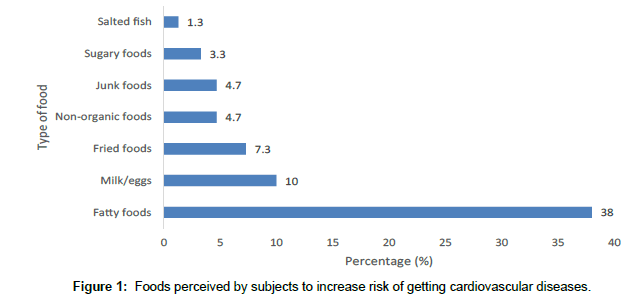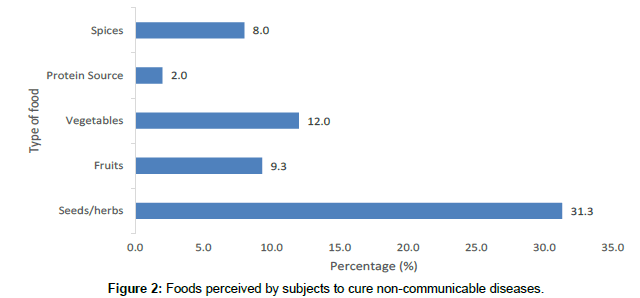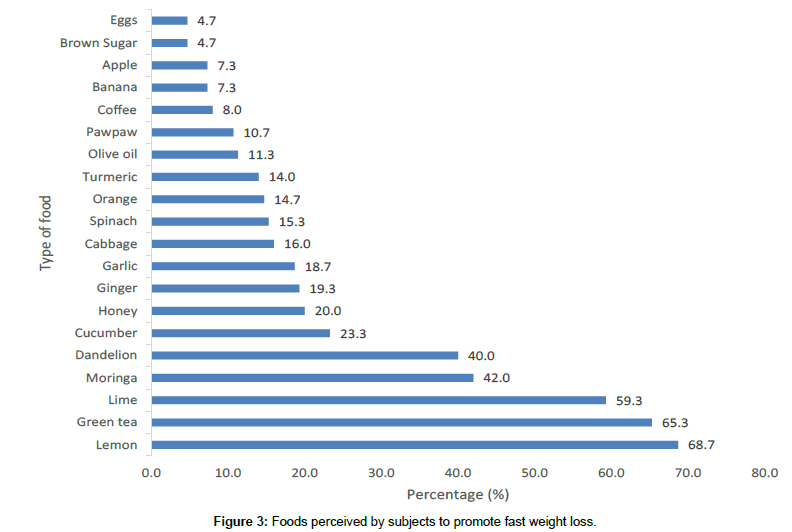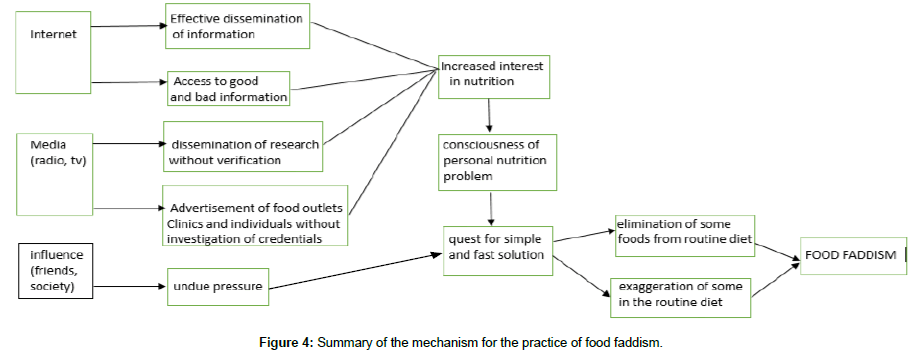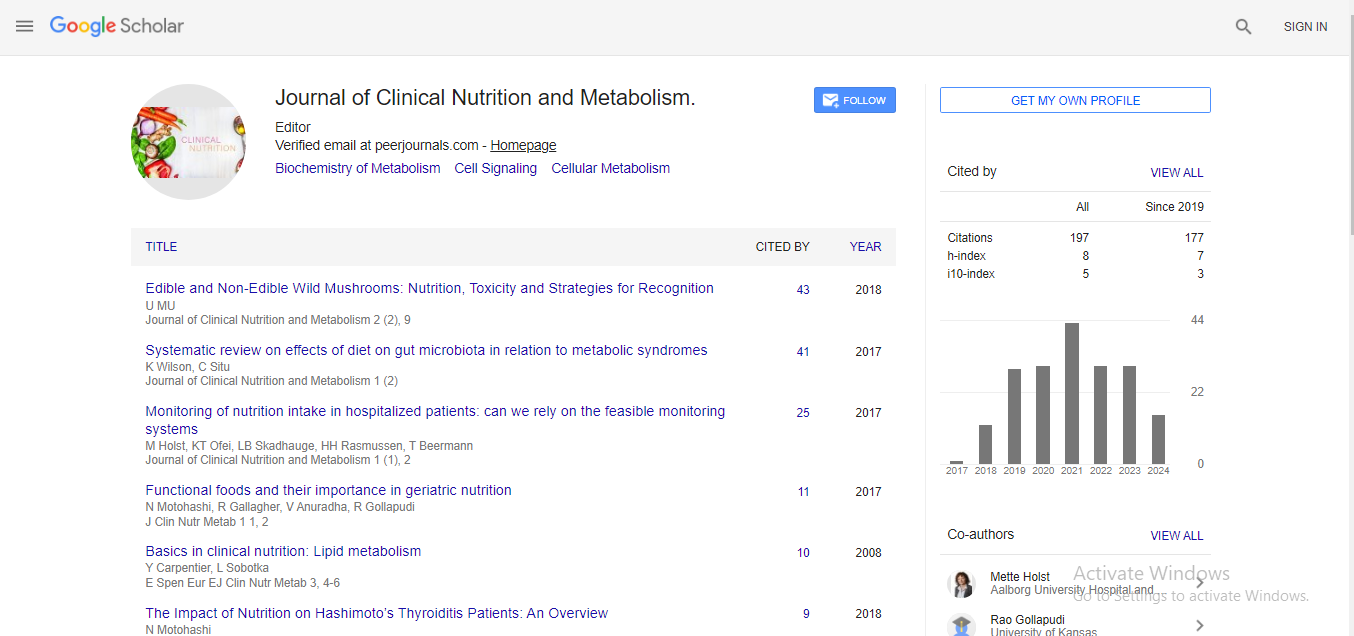Research Article, J Clin Nutr Metab Vol: 1 Issue: 1
Food Faddism: Its Determinants, Prevalence and Practices among Adult University Students in Ghana
Frederick Vuvor*, Linda Fabea and Obed Harrison
Department of Nutrition and Food Science, School of Biological Sciences, College of Basic and Applied Sciences, University of Ghana, Ghana
*Corresponding Author : Frederick Vuvor
Department of Nutrition and Food Science, School of Biological Sciences, College of Basic and Applied Sciences, University of Ghana, P.O Box: LG 134, Legon-Accra, Ghana
Tel: +233244608344
E-mail: fredvuvor@yahoo.com
Received: September 09, 2017 Accepted: September 19, 2017 Published: September 26, 2017
Citation: Vuvor F, Fabea L, Harrison O (2017) Food Faddism: Its Determinants, Prevalence and Practices among Adult University Students in Ghana. J Clin Nutr Metab 1:1.
Abstract
Background: Food faddism is any dietary practice that either eliminates one or more of the essential food groups, or recommends consumption of one type of food in excess at the expense of other foods for extraordinary health benefit. It is of an extreme, exploitive and dubious nature, intended to produce results more quickly. This study therefore sought to identify the determinants, prevalence and the nature of the practice of food faddism.
Methods: This study was cross-sectional involving 150 university students in Ghana. WHO Stepwise questionnaires were modified to collect all information. The data were analysed using SPSS and Excel software.
Results: Prevalence of various forms of food faddism was found to be 65.3%. Ethnicity (p=0.045) and occupation of household head (p=0.046) were found to be influencing factors associated with the practice. Major explanations given for the practice were detoxification (48.0%) and enhancing functions of some body parts (41.3%). Foods associated with food faddism were mostly fruits, vegetables, seeds and herbs.
Conclusion: Prevalence of food faddism was found to be unacceptably high among these students of higher learning (University). It can be inferred that if the prevalence of food faddism is so high among university students, then it could be projected that worse occurrences may be happening among people of lower levels of education.
Keywords: Food; Faddism; Nutritional status; Health; Fad
Introduction
Food faddism is a term used to describe a particular food or food groups that is exaggerated or eliminated in order to achieve a specific health benefit [1]. There is a strong relationship between diet and health. Hence consumption of inappropriate food or food combination or poor eating habit could be a source of ill health. “Let food be thy medicine and medicine be thy food” by Hippocrates gives more insight to this issue [2]. Basically, food faddism gives health claims that are not supported by scientifically valid evidence [3]. Food faddists are therefore, individuals who adopt a diet practice which promises benefits with no scientific proof [1]. Such people have thoughts, and expectations about foods that are in line with their beliefs [4]. A study found that some folks disregard comprehensive health report and involve themselves with foods that may lead to health complications [5]. The apparent role of food has shifted over the past two decades from averting deficiency diseases to delaying aging, preventing and curing chronic health problems [6]. It is a serious source of distraction to nutrition principles.
It was discovered that dissatisfaction of the society with the orthodox health delivery system has led to some people to seek alternative lifestyle and food habits [7]. For instance, there has been an escalating pressure on women to be of particular shapes making them to seek easy solutions. Also, diversity of cultures and the use of natural remedies may lead to a rise in the practice. Food faddism basically occurs in four major forms. These include special properties of food being exaggerated and said to cure specific diseases, certain foods being eliminated from the diet due to the belief of the presence of harmful constituents, the belief that some foods or a combination of foods have superior health enhancement and emphasis placed on eating ‘health foods’, natural or organic foods [4,8]. The entire concept therefore is highly questionable since a healthy diet is all about adequacy and variety/food diversity and balance [9]. Starvations and extremely low caloric diet coupled with excessive intake of some fruits and herbs as done by food faddists unvaryingly lower the basal metabolic rate as the body struggles to reserve energy. As soon as the individual recommences usual eating, there is rapid weight gain since most of the weight lost was through fluid loss. Discovering the prevalence of food faddism would facilitate nutritionists and dieticians in educating general public on food faddism [4]. Very little studies were done in Ghana involving food faddism. Therefore, the current study was designed to assess its determinants, prevalence and mode of practices among college adult Ghanaians students.`
Materials and Methods
The study was cross-sectional carried out in the University of Ghana, with a population of about 37,940 students. Out of 15 halls of residence in the University of Ghana, 6 halls were selected randomly for this study. The students sampled were between the ages of 18- 25 years in the first and fourth year making total of 150 across all disciplines. The second and third year students were excluded because they were classified as the transition stage/sophomore between the plebe/neophyte and the final year undergraduates. It was suspected that food habit of students could change from first year to final year by the exclusive environment (university campus life). University students were selected because it was believed that students would be better informed than illiterate as they have access to many literatures from all fields of study. WHO Stepwise questionnaire was modified to collect all the data such as demographic, socioeconomic, dietary, food/eating behaviours that are described as fad; their determinants, prevalence, perception, knowledge, practices and implications. The questionnaire was pretested with students of similar characteristics from the other six non-selected halls.
Data Analysis and Results
Data was analysed using combination of SPSS version 22.0 and Excel software. Categorical variables were presented as frequencies and percentages while continuous ones were presented as means and standard deviations. The Pearson’s chi-square test was used to determine the association between variables of interest. Perceptions and reasons on some foods and eating habit were categorized under themes obtained from the interviews.
Discussion
One of the lifestyles that affect health of individuals and communities is dietary habit. In recent years, emphasis has been placed on eating certain foods to express a particular lifestyle [4]. The current study focused on university students in Ghana who are believed to be knowledgeable and hence are assumed less vulnerable to food faddism. About 59.3% of them were in fourth year and a major percentage offered programs in the college of humanities. Subjects were from two major ethnic groups and for confidentiality purpose A and B was assigned to those ethnic groups: A (56.7) and B (44.3) (Table 1). Out of 150 students who participated in the study, as high as 98 (65.3%) indulged in the practice of food faddism (Tables 2 and 3). It was found that majority of the food faddists (58.2%) were females (Table 4). This finding is corroborated with a study reported in India [1] that revealed that the prevalence of food faddism among females of child bearing age was about 71.5%. Studies have also found that low birth weight or intra-uterine growth retardation in children were as a result of food faddism among women. In addition poor dietary habit including food faddism and low maternal education are major causes of micronutrient deficiencies in most developing countries [10-14]. Table 2 displays that subjects who practice food faddism do so mostly for detoxification (48%), boosting of the performance of some body parts (41.3), weight loss (36.7%), prevent illness in later life (36.7%) and also to cure diseases (28%) respectively. All subjects practice food faddism for more than one reason. A study has showed that 16.08% of females in India practiced food faddism mainly for weight loss [1].
| Variable | n (%) |
|---|---|
| Sex | |
| Male | 71 (47.3) |
| Female | 79 (52.7) |
| Year of education | |
| 1st year | 61 (40.7) |
| 4th year | 89 (59.3) |
| Ethnicity | |
| #A | 85 (56.7) |
| #B | 65 (44.3) |
| Colleges | |
| Humanities | 92 (61.3) |
| Basic And Applied Science | 44 (29.3) |
| Health Science | 8 (5.3) |
| Education | 6 (4.0) |
| Father’s occupation | |
| Salaried Worker | 88 (58.7) |
| Self employed | 62 (41.3) |
| Mother’s occupation | |
| Salaried Worker | 56 (37.3) |
| Self employed | 94(62.7) |
| Household head’s occupation | |
| Salaried Worker | 88 (58.7) |
| Self employed | 62 (41.3) |
Table 1: Socio-demographic Information of Subjects (N=150).
| Reason | Sources | n (%) |
|---|---|---|
| Weight loss | Internet | 24 (16) |
| Friends | 15 (10.0) | |
| Parents | 16 (10.6) | |
| Cure | Internet | 14 (9.3) |
| Parents | 19 (12.6) | |
| Friends | 9 (6.0) | |
| Prevent illness in later life | Internet | 25 (16.7) |
| Parents | 22 (14.7) | |
| Friends | 8 (5.3) | |
| Boost performance of body parts | Internet | 24 (16.0) |
| Parents | 29 (19.4) | |
| Friends | 9 (6.0) | |
| Detoxification | Internet | 42 (28.0) |
| Parents | 13 (8.7) | |
| Friends, Religion | 17 (11.4) | |
| Prescription | Yes | 39 (26.0) |
| No | 111 (74.0) |
Table 2: Reasons and sources of information for the practice of food faddism among subjects.
| Variables | n (%) |
|---|---|
| Associated with weight loss | |
| Fruits/ Vegetables | 44 (29.3) |
| Herbs | 14 (9.3) |
| Spices | 8 (5.3) |
| honey, beans, eggs, milk | 21 (14.0) |
| Associated with curing of specific diseases | |
| Fruits/vegetables | 28 (18.7) |
| Herbs | 7 (4.7) |
| Spices | 5 (3.3) |
| honey, eggs, milk | 14 (9.3) |
| Associated with prevention of illness in later life | |
| Fruits/vegetables | 6 (4.0) |
| Seeds/Herbs | 8 (5.3) |
| Sugar | 20 (13.3) |
| Canned foods, starchy foods, spices | 26 (17.3) |
| Associated with boosting of the performance of body parts | |
| Fruits/vegetables | 38 (25.4) |
| Herbs | 4 (2.7) |
| Honey | 18 (12.0) |
| Protein source | 12 (8.0) |
| Associated with detoxification of the | |
| Fruits/vegetables | 61 (40.7) |
| Herbs | 25 (16.7) |
| Spices | 7 (4.7) |
| Honey | 6 (4.0) |
| Vinegar + milk | 3 (2.0) |
Table 3: Perceptions of subjects on somecertain benefits associated to some foods.
| Variable | Food Faddists n (%)N=98 | Non-Food Faddists n (%)N=52 | P-Value |
|---|---|---|---|
| Sex | |||
| Male | 41 (41.8) | 30 (57.7) | 0.064 |
| Female | 57 (58.2) | 22 (42.3) | |
| Level | |||
| 100 | 37 (37.8) | 24 (46.2) | 0.319 |
| 400 | 61 (62.2) | 28 (53.8) | |
| Age groups | |||
| 18-20 | 35 (35.7) | 26 (50) | 0.064 |
| 21-25 | 60 (61.2) | 22(42.3) | |
| ≥26 | 3 (3.1) | 4 (7.7) | |
| Ethnicity | |||
| #A | 47 (48.0) | 38 (73.1) | 0.045* |
| #B | 51 (52.0) | 14 (26.9) | |
| Father’s occupation | |||
| Salaried Worker | 62 (63.3) | 26 (50) | 0.068 |
| Self employed | 36 (36.7) | 26 (50) | |
| Mother’s occupation | |||
| Salaried Worker | 39 (39.8) | 17 (32.7) | 0.394 |
| Self employed | 59 (60.2) | 35 (67.3) | |
| Household head’s occupation | |||
| Salaried Worker | 64 (65.3) | 25 (48.1) | 0.046* |
| Self employed | 34 (30.6) | 27 (51.9) | |
| Level of knowledge in nutrition | |||
| Low | 76 (77.6) | 37 (71.2) | 0.387 |
| High | 22 (22.4) | 15 (28.8) |
#A and #B are major ethnic groups in Ghana
Table 4: Association of variables with the practice of food faddism.
The success of most dietary approaches to weight loss goes together with modification of lifestyle affecting physical activity and food habit. The best way of achieving a healthy weight includes a healthy diet with an energy level that does not exceed energy expenditure and can be sustained in the long term [15-17]. Moreover, detoxification is originally a medical procedure used to wean the body of toxins such as excess alcohol and drugs but food faddists believe it is aimed at cleansing the body of alleged toxins derived from metabolic by-products [18]. Many studies demonstrated that there is no evident benefit for detoxification however; it has been associated with risks which depends on the nature of the detox treatment and can be particularly serious with diets (malnutrition) and supplements (hepatoxicity) [19-22]. Although many studies have shown that the body has enough capacity to get rid of several toxins through the functions of certain organs, foods such as milk thistle, turmeric and green tea have been reported to facilitate this process [23].
From this study, subjects eliminated or included some food in their diets so as to prevent or cure illness such as diabetes mellitus, hypertension, cancer, eye problem, stroke, obesity and arthritis respectively. Most of these illnesses are nutrition-related noncommunicable diseases that can be prevented through healthy lifestyle. It is valid that dietary habits such as high consumption of added sugar, salt, saturated fat, trans fat, alcohol coupled with low consumption of fruits, vegetables and fibre puts one at a very high risk of developing non-communicable diseases. A study proved that factors such as age, environmental contaminant, genetics, sedentary lifestyle, smoking, tobacco use and stress puts one at risk too. Also dietary factors coupled with exercise has the ability to adjust mental health due to its role in influencing cognitive capacity [24]. It is believed that tiger nut stimulates sexual arousal but a study has cited that there has been no scientific evidence to support this claim. However, the results of their study revealed that tiger nut has positive effect on the copulatory behaviour of adult male rats and may be due to increased serum testosterone, which is also related to the presence of quercetin, vitamins and zinc in tiger nut [25].
A study has suggested that the amount and quality of carbohydrate in diet influence reproductive functions yet, many conflicting data are present as one study showed that high carbohydrate intake is associated with increased risk of an ovulatory infertility. In addition, protein intake may differently affect female fertility depending on the source but very few studies showed the damages in the reproductive structures among vegetarians and non-vegetarian women. It was observed from this study that the foods mentioned to boost the functioning of the female reproductive organ such as coconut, tiger nut, garlic, green tea and others may have little or no effect at all and hence a healthy diet coupled with moderate physical activity is enough to keep the body working at its best [26].
Table 2 of this study depicts that majority of the food faddists received nutrition information (their source of reasons for practicing food faddism) from the social media or the internet followed by advice from parents, society/culture and friends. A study suggested that 79.31% of food faddists in India had their information from parents and family whereas 7.8% received information from friends [1]. Many forms of deceit and dangers are on the internet through advertisements, recommendations and guidelines and hence consumers must remain vigilant. For instance, websites and mass media may promote products by quoting researchers or physicians but such source may not even exist [27].
Food faddism can be related to socio-demographic factors since nutritional status and nutritional practices still depends upon the socio-demographic profile of a population. In Table 4, ethnicity (p=0.045) and occupation of household head (p=0.046) were found to be associated with the practice of food faddism. The other variables had no association. This illustrates that ethnicity and occupation of household head affects the practice of food faddism. It was discovered that family type (p=0.01) and level of education (p=0.04) affect the practice of food faddism among women of child bearing age in India. This study however proved otherwise (family type had p-value of 0.797 and level of knowledge had p-value of 0.387). Although there was no association between food faddism and level of knowledge in nutrition, 22.4% of the food faddist had high level of knowledge in nutrition and 77.6%, low level of knowledge in nutrition (Table 4). This shows that literates with low level of knowledge in nutrition are victims as much as illiterates are [1].
It was specified that one of the major factors that affect food choices is culture [5]. This explains why food faddism was associated with ethnicity since ethnicity is bound by culture. McBean and Speckman [4] suggested that due to the strong belief system attached to foods by food faddists, their attitudes concerning food are an expression of themselves. Insel et al. [5] stated again that socio-economic status of an individual affects his or her purchasing power. Occupation can be used as a tool to assess one’s socio-economic status [28]. In this study, it was observed among the food faddists that 34(30.3%) had selfemployed household heads whereas 64(69.7%) were salaried workers. Memon et al. found in a study that, 51.34% of the subjects who practice food faddism were from low socio-economic class [1]. According to Insel et al. other factors such as religion and environment affect food choices however in this study there was no association between such factors [5].
As seen in Figure 1, majority of participants suggested that, consumption of fatty foods increases one’s chance of getting cardiovascular diseases (38.0%). About 10% suggested animal source protein. It has been established that excessive consumption of added sugar, table salt, saturated fat, trans fat and alcohol increases one’s risk of getting cardiovascular diseases [29]. Some foods were mentioned by participants to cure non-communicable (Figure 2). Such foods include seeds and herbs, fruits and vegetables and spices. Nonetheless, it has been declared that no food can cure non-communicable diseases but they can be managed through diet and other factors [29]. Furthermore, most participants opined that consuming some foods or a combination of them facilitate fast weight loss (Figures 3 and 4).
Many studies have reported on moringa as well as other medicinal herbs that its leaves, roots and bark has phytochemicals, antibiotic and cancer prevention substance which are good to be consumed for medicinal purposes but excessive consumption may lead to nutrient toxicity. Moringa leaves are rich in starch, minerals, iron, vitamin A, B, C and E, calcium, and protein. It contains high amount of magnesium, phosphorus, potassium, copper, sulphur and oxalic acid. This shows that excessive consumption of moringa as observed in food faddist can pose one to a high risk of nutrient toxicity which is liable for complications in certain organs such as the kidney and liver. Conversely, its ability to promote weight loss along with other medicinal herbs such as green tea, prekese (Tetrapleura tetraptera), dandelion and many more has not yet been established [30-34].
Conclusion
To conclude the prevalence of food faddism is high among adult Ghanaians which may be partially due to unawareness but strongly associated to socioeconomic status and ethnicity the reasons for the practice of food faddism are detoxification, boosting of performance, prevention of illness in later life, weight loss and curing of illness. It could therefore be hypothesized that if the prevalence of food faddism is so high among students of high knowledge, critical incidence can be expected among illiterates or the general population and hence a more intense research should be done to highlight the underlying factors.
Acknowledgements
Authors express their appreciation to the study participants, hall of residence authorities, Teaching/Research Assistants from the Department of Nutrition and Food Science, University of Ghana for their assistance.
References
- Memon KN, Shaikh K, Khaskheli LB, Shaikh S, Memon S (2014) Food Faddism; Its Determinants & Health Outcomes Among Residents of Taluka Latifabad, Hyderabad. Professional Med J 1: 21.
- Biziulevicius GA, Kazlauskaite J (2007) Following Hippocrates’ advice ‘Let food be thy medicine and medicine be thy food’: An alternative method for evaluation of the immunostimulatory potential of food proteins. Med Hypotheses 68: 712-713.
- Wardlaw GM, Hampl JS (2007) Perspectives in Nutrition. Mc Graw Hill Higher Education, New York, USA, 149-190
- McBean LD, Speckmann EW (1974) Food faddism: a challenge to nutritionists and dietitians. Am J Clin Nutr 27: 1071-1078.
- Insel P, Turner R, and Ross D (2005) Nutrition. Jones and Barlett Publishers Inc, USA.
- Abdullah M, Mohammed W, Ismail M (2014) Nurses’ Knowledge and Practices about Administration of Medications via Nasogastric Tube among Critically Ill Patients. Journal of Education and Practice 5: 147-159.
- Wahlqvist ML (2013) The clinical practice of food security. ACNEM journal 32: 33.
- Ekvall SW, Ekvall VK, Niedbala B (2017) Pediatric and Adult Nutrition in Chronic Diseases, Developmental Disabilities, and Hereditary Metabolic Disorders: Prevention, Assessment, and Treatment. Oxford University Press, USA.
- Sizer FS, Whitney EN, Piché LA (2012) Nutrition: concepts and controversies. Cengage Learning, USA.
- Roberts IF, West RJ, Ogilvie D, Dillon MJ (1979) Malnutrition in infants receiving cult diets: a form of child abuse. Br Med J 1: 296-298.
- Bhutta ZA, Haider BA (2009) Prenatal micronutrient supplementation: Are we there yet? CMAJ 180: 1188-1189.
- Malhotra N, Puri R, Malhotra J, Malhotra N, Rao JP (2010) Maternal-Fetal Work-up and Management in Intrauterine Growth Restriction. Donald School J Ultrasound Obstet Gynecol 4: 427-432.
- Duggan C, Watkins JB, Walker WA (2008) Nutrition in pediatrics: basic science. clinical applications, USA.
- Radi S, Abu Mourad T, Papandreou C (2009) Nutritional status of Palestinian children attending primary health care centers in Gaza. Indian J Pediatr 76: 163-166.
- WHO/FAO (2003) Diet, nutrition and the prevention of chronic diseases. Geneva, Switzerland.
- Galuska DA, Khan LK (2001) Obesity: a public health perspective, Present knowledge in nutrition, 531-542.
- Dwyer JT, Melanson KJ, Sriprachy-anunt U, Cross P, Wilson M (2015) Dietary treatment of obesity.
- Ernst E (2012) Alternative detox. Br Med Bull 101: 33-38.
- Mishori R, Otubu A, Jones AA (2011) The dangers of colon cleansing. J Fam Pract 60: 454-457.
- Ernst E (2009) Deaths associated with EDTA chelation therapy—a systematic review. Perfusion 22: 9-11.
- Ernst E (2004) Ear candles: a triumph of ignorance over science. J Laryngol Otol 118: 1-2.
- Bryant SM, Kolodchak J (2004) Serotonin syndrome resulting from an herbal detox cocktail. Am J Emerg Med 22: 625-626.
- Hu F (2008) Obesity epidemiology, Oxford University Press, India.
- Fernando NT, Koch M, Rothrock C, Gollogly LK, et al. (2008) Tumor escape from endogenous, extracellular matrix–associated angiogenesis inhibitors by up-regulation of multiple proangiogenic factors. Clin Cancer Res 14: 1529-1539.
- Allouh MZ, Daradka HM, Abu Ghaida JH (2015) Influence of Cyperus esculentus tubers (Tiger Nut) on male rat copulatory behavior. BMC Complement Altern Med 15: 331.
- Fontana R, Della Torre S (2016) The deep correlation between energy metabolism and reproduction: a view on the effects of nutrition for women fertility. Nutrients 8: 87.
- Rolfes SR, Pinna K, Whitney EN, Rolfes SR (2001) Normal and clinical nutrition.
- Galobardes B, Shaw M, Lawlor DA, Lynch JW, Davey Smith G (2006) Indicators of socioeconomic position (part 1). J Epidemiol Community Health 60: 7-12.
- Whitney E, Rolfes S (2011) Energy Balance and Body Composition in Understanding Nutrition.
- Fahey JW (2005) Moringa oleifera: A Review of the Medical Evidence for Its Nutritional, Therapeutic, and Prophylactic Properties. Trees for life Journal 1: 5.
- Rajangam J, Azahakia Manavalan RS, Thangaraj T, Vijayakumar A, Muthukrishan N (2001) Status of production and utilisation of Moringa in Souther India, Dar Es Salaam, Tanzania.
- Donovan P (2008) Moringa Oleifera: The Miracle Tree.
- Foidl N, Makkar H, Becker K (2001) The potential of Moringa oleifera for agricultural and industrial uses, Dar Es Salaam, Tanzania.
- Hsu R, Midcap S, Arbainsyah DW, De Witte L (2006) Moringa oleifera; medicinal and socioeconomic uses.
 Spanish
Spanish  Chinese
Chinese  Russian
Russian  German
German  French
French  Japanese
Japanese  Portuguese
Portuguese  Hindi
Hindi 